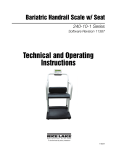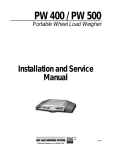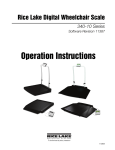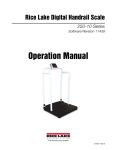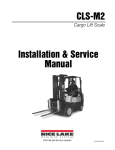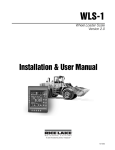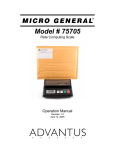Download Bariatric Handrail Scale w/ Seat
Transcript
Bariatric Handrail Scale w/ Seat 240-10-1 Series Software Revision 11387 Operation Instructions To be the best by every measure 114557 Contents 1.0 2.0 Introduction.................................................................................................................................. 1 Scale Assembly ........................................................................................................................... 2 2.1 2.2 2.3 2.4 3.0 Unpacking Your Scale . . . . . . . . . . . . . . . . . . . . . . . . . . . . . . . . . . . . . . . . . . . . . . . . . . . . . . . . . . . . Repacking . . . . . . . . . . . . . . . . . . . . . . . . . . . . . . . . . . . . . . . . . . . . . . . . . . . . . . . . . . . . . . . . . . . . . Setting Up Your Scale . . . . . . . . . . . . . . . . . . . . . . . . . . . . . . . . . . . . . . . . . . . . . . . . . . . . . . . . . . . . Getting Ready to Weigh a Patient . . . . . . . . . . . . . . . . . . . . . . . . . . . . . . . . . . . . . . . . . . . . . . . . . . . . 2 2 2 6 Scale Operation ........................................................................................................................... 7 3.1 Weighing . . . . . . . . . . . . . . . . . . . . . . . . . . . . . . . . . . . . . . . . . . . . . . . . . . . . . . . . . . . . . . . . . . . . . . 7 3.2 Using the Body Mass Index (BMI) Function. . . . . . . . . . . . . . . . . . . . . . . . . . . . . . . . . . . . . . . . . . . . . 8 3.3 Using the Tare Function . . . . . . . . . . . . . . . . . . . . . . . . . . . . . . . . . . . . . . . . . . . . . . . . . . . . . . . . . . . 9 4.0 RS-232 Communication ............................................................................................................. 10 4.1 Pushbutton Keypad Print . . . . . . . . . . . . . . . . . . . . . . . . . . . . . . . . . . . . . . . . . . . . . . . . . . . . . . . . . 10 5.0 6.0 Troubleshooting ......................................................................................................................... 11 Maintenance .............................................................................................................................. 12 6.1 Basic Maintenance . . . . . . . . . . . . . . . . . . . . . . . . . . . . . . . . . . . . . . . . . . . . . . . . . . . . . . . . . . . . . . 12 6.2 Cleaning . . . . . . . . . . . . . . . . . . . . . . . . . . . . . . . . . . . . . . . . . . . . . . . . . . . . . . . . . . . . . . . . . . . . . . 12 7.0 Digital Bariatric Handrail Scale Specifications ........................................................................ 13 For More Information ............................................................................................................................. 14 Digital Bariatric Handrail Scale Limited Warranty................................................................................ 15 Technical training seminars are available through Rice Lake Weighing Systems. Course descriptions and dates can be viewed at www.ricelake.com or obtained by calling 715-234-9171 and asking for the training department © 2010 Rice Lake Weighing Systems. All rights reserved. Specifications subject to change without notice. Series 240-10-1, Software revision 11387 November 2010 Rice Lake continually offers web-based video training on a growing selection of product-related topics at no cost. Visit www.ricelake.com/webinars. ii Bariatric Handrail Scale Operation Instructions 1.0 Introduction The Rice Lake Digital Bariatric Handrail Scale with fold down seat is designed for weighing bariatrics and ensures sound, accurate weighing information. A non-skid platform paired with side rails assists persons who need extra support and safety. The fold down chair allows patients to sit down while being weighed. The scale is set up to use motion sensing technology, to determine the actual weight of a moving patient. The weight is displayed on the indicator and can be displayed in pounds or kilograms and has an impressive 1000 lb capacity. This manual can be viewed and downloaded from the Rice Lake Weighing Systems web site at www.ricelake.com/health. Technical information on this product and other medical products are available on the Rice Lake Weighing Systems web site. Rice Lake Weighing Systems is an ISO 9001 registered company. Figure 1-1. Digital Bariatric Handrail Scale with Fold Down Chair 1 2.0 2.1 Scale Assembly Unpacking Your Scale Place the unopened box in an open area that has ample room for unpacking the scale. Parts contained in the shipping box include: • The scale • This manual • Small box containing AC adaptor and RS-232 cable • 6 mm Allen Key 2.2 Repacking If the Digital Bariatric Handrail Scale must be returned for modification, calibration or repair, it must be properly packed with sufficient packing materials. Whenever possible, use the original carton when shipping the scale back. NOTE: Damage caused by improper packaging is not covered by the warranty. 2.3 Setting Up Your Scale Use the following steps to set up the Digital Bariatric Handrail Scale with seat. 1. Locate the user’s manual from inside the box and set aside as it will provide instructions on the proper scale removal and set up. 2. Using two people, remove the scale out of the packaging material that it came in by lifting the scale out of the box by the scale base. NOTE: DO NOT lift the scale out of the box by its handle as this can cause the hinges to break. 3. Move the scale into the area where the weighing process will occur. It’s recommended to place the scale on a hard, level surface for the most accurate weighments. Thin carpeting is fine but not recommended. 4. Gently set the scale platform down to the floor. 5. Loosen the handles and unfold and set upright. 6. Screw in all four legs. 7. Attach the wrap around rails. 8. Tighten the hex screw head using the enclosed 6 mm Allen key to stabilize the scale. Adjusting the Scale Feet There must be adequate clearance between the scale base and the floor so screw each foot out counterclockwise two full turns. This will ensure that there is enough clearance between the scale base and the floor. Gently set the scale base down to the floor. There should be minimal clearance between the scale base and the floor without having the scale base actually touching the floor. By not having clearance around the scale base will cause inaccurate weighments. It’s also important to make sure that the scale is completely level. Gently press down on all corners of the scale base to ensure that there are no high spots or rocking of the scale base. 2 Bariatric Handrail Scale Operation Instructions Unfold Platform Seat The Digital Bariatric Handrail Scale comes with a fold down seat for those patients who need to be weighed while seated. To unfold the seat, simply pull down on the seat bottom as shown in Figure 2-1. Figure 2-1. Unfolding the Seat Bariatric Handrail Scale Operation Instructions - Scale Assembly 3 AC Power Connections The Digital Bariatric Handrail Scale has a 120 VAC adaptor or 230 VAC adaptor to use when power is readily available. The AC power adaptor plugs into the back of the indicator as shown in Figure 2-2. Retaining Screw Connect the AC power source here LED indicator light illuminates from red to green when charged RS-232 port connection Store the 120 VAC adaptor here when not in use Store the 230 VAC adaptor here when not in use Back cover to indicator Figure 2-2. LED Light Location The AC adaptor, when not in use, plugs into the back housing of the indicator for storage. Figure 2-2 shows that location. The Digital Bariatric Handrail Scale is capable of running its internal sealed lead-acid rechargeable battery if no additional power source is available. Battery life is approximately 75 hours. If the LO Bat indicator is showing on the display, recharge the battery or connect the scale to an AC power source as soon as possible for accurate weighing. Battery Charging When the AC adaptor is connected to a power source, the rechargeable battery goes into recharge mode. NOTE: To maintain battery longevity we recommend you charge it on a regular basis rather than waiting until it is fully discharged. The LED indicator light on the back of the scale housing will illuminate red during the charging period, and change over to green when the battery becomes fully charged. Attaching the Indicator to the Scale Handle Use the following steps to attach the indicator to the scale. 1. Unscrew the four back cover screws, remove the back cover and place screws in a secure place along with the back cover. The screw location is shown in Figure 2-3. 2. Unscrew the six screws on the back panel plate of the scale and position the indicator to it and screw 4 Bariatric Handrail Scale Operation Instructions back the six screws to secure the indicator to the scale handle as shown in Figure 2-3. Six screws that hold the indicator to the scale handle (only three screws showing). Figure 2-3. Mounting Bracket Screw Location Load Cell Connections To gain access to the load cell connection point, remove the four back retaining screws as shown inFigure 2-3. Figure 2-4 illustrates where the load cell connection point is. Load Cell Connection Point Figure 2-4. Load Cell Connection Point Connect the load cell into the load cell connection point. You will hear a "click" affirming a secure connection. Put the back on the indicator and secure with the four back cover screws that were previously set aside. Bariatric Handrail Scale Operation Instructions - Scale Assembly 5 2.4 Getting Ready to Weigh a Patient Once the scale is properly unpacked and set up, and prior to weighing a patient, step on the scale to check the scale that all functions are working correctly. The scale is calibrated from the factory so simply turn on the scale and step on the scale to get a weight reading. Press the REWEIGH key again to verify that weight. Figure 2-5. Press the Reweigh Key to Verify Weight 6 Bariatric Handrail Scale Operation Instructions 3.0 Scale Operation The display has various front panel keys. They are shown below. Figure 3-1. Front Panel Display Keys Key Name ON-OFF/ZERO Function ON-OFF - Switches the scale on or off. ZERO - Clears weight off the scale and returns it back to zero. BMI/TARE BMI - Enables the user to access the BMI (Body Max Index) function. TARE - Used to subtract a weight off the scale ie: wheelchair. REWEIGH Allows you to reweigh a patient without having them leave the scale. Kg-Lb/PRINT Allows the user to toggle between kilograms and pounds. Press this key to print a weight if connected to a printer. Table 3-1. Key Functions #AUTION The keys on the front panel display are very sensitive so only a gentle pushing motion is required to obtain results. The scale has the capability of performing different operations beyond just calculating weight. The various operating instructions are described below. 3.1 Weighing Use the following steps to weigh a person. 1. Press the On-Off/Zero key to turn on the scale and 0.0 will appear on the display. 2. Have the patient step onto the scale. The display shows WEIGH, then the patient’s weight, and beeps to indicate the end of the weighing process. 3. To ensure an accurate weighing, press the REWEIGH key. 4. To change the display from Kg to Lb and vice-versa, press the Kg-Lb key. 5. The scale is set to lock in the weight when the weighing process is complete. The weight will remain on the display even after the patient exits off the scale. To clear the weight, press the On-Off/Zero key. 6. To turn off the scale, press and hold the On-Off/Zero key until OFF appears on the display. Bariatric Handrail Scale Operation Instructions - Scale Operation 7 3.2 Using the Body Mass Index (BMI) Function Body mass index (BMI) is the relationship between weight and height associated with body fat and health risk. It is a reliable indicator of body fatness for people and even though BMI does not measure body fat directly, research has shown the BMI correlates to direct measures of body fat. BMI is an inexpensive and easy-to-perform method of screening for weight categories that may lead to health problems for adults. Calculating BMI is one of the best methods for population assessment of overweight and obesity. Because calculation requires only height and weight, it is inexpensive and easy to use for clinicians and for the general public. The calculation is based on the following formulas: Calculate BMI by dividing weight in pounds (lbs) by height in inches (in) squared and multiplying by a conversion factor of 703. Example: weight = 150 lbs, height = 5’5 (65") Calculation: [150 ÷ (65)2] x 703 = 24.96 The standard weight status categories associated with BMI ranges for adults are shown in the following table. BMI Weight Status Below 18.5 Underweight 18.5 - 24.9 Normal 25.0 - 29.9 Overweight 30.0 and Above Obese Table 3-2. Standard Weight Status The following examples show weight ranges, the corresponding BMI ranges and the weight status categories for a sample height. Height 5’9” Weight Range BMI Weight Status 124 lbs or less Below 18.5 Underweight 125 lbs to 168 lbs 18.5 to 24.9 Normal 169 lbs to 202 lbs 25.0 to 29.9 Overweight 203 lbs or more 30 or higher Obese Table 3-3. BMI Ranges and Weight Status Example Use the following steps in determining the BMI. 1. To use the BMI function, weigh the patient as described under Weighing (above) and then press the BMI key. If weighing in Lbs, the default height of (5 feet) appears on the display. Use the up or down arrows to increase the feet height by one foot increments). Press the BMI key again to display inches (default is 7.0 inches) Again, use the up or down arrows to increase or decrease the inches height by 0.5" increments. Press the BMI key again to accept the inches value. The final height value will be displayed ie: 5-07.5 = 5’ 7.5". 2. If you are weighing in Kgs, the default will be 170.0 cm. Use the up or down arrows to increase or decrease by 0.5 cm increments. 3. To see the patient’s calculated BMI, press the BMI key again. The BMI appears. 4. To cancel the BMI display, press the BMI key. 8 Bariatric Handrail Scale Operation Instructions 3.3 Using the Tare Function You can use the tare function for deducting an extra weight (such as a wheelchair, or medical equipment attached to the patient) in a weighing operation. Use the following steps to use the tare function. 1. With the scale set to 0.0, place the extra load (wheelchair) on the scale. The display shows WEIGH and then the weight of the load. 2. Press and hold the TARE key until TARE appears on the display. The display returns to 0.0 and TARE appears on the left side of the display. 3. Remove the load from the scale. The weight of the load appears with a negative symbol to the left of it. 4. Have the patient step onto the scale. The display then shows the patient’s weight with the load weight deducted. 5. The weight of the load remains stored in memory, so you can continue to weigh patients who are carrying the same tare weight. For example, when using the same wheelchair for weighing more than one patient. 6. To cancel the tare weight, press and hold the TARE key until TARE disappears from the display and the display returns back to 0.0. The tare weight is also cancelled when the scale is turned off. Use the following steps to enter a tare without placing that item on the scale. An example of this would be if you’ve got a patient in a wheelchair and the wheelchair has a known weight (has been tagged) you can enter that weight manually. 1. With the scale set to 0.0 Lbs (there must be no weight on the scale), press the TARE key. The display will alternate between a value and the word TARE. 2. To change the value, press and hold the Kg/Lb key until the right most digit is equal to the first digit of the value you want. Example: If you want 103.5, hold the key until the display is 0.1. 3. To advance to the next digit, press the Kg/Lb key twice quickly. The digit you changed will move left and the right most digit will again be 0. Again, hold the Kg/Lb key until the right most digit is equal to the next digit in the numbers you want. 4. Continue as in Step 3 until you are displaying the value you want, then press the TARE key. 5. You can now accurately weigh the patient. 6. To cancel the tare weight, press and hold the TARE key until TARE disappears from the display and the display returns back to 0.0. The tare weight is also cancelled when the scale is turned off. Bariatric Handrail Scale Operation Instructions - Scale Operation 9 4.0 RS-232 Communication The scale comes with an RS-232 port which enables weight data to be transmitted to other equipment, such as a computer or printer. The RS-232 cable with DB-9 connector (PN 100719) is available from Rice Lake Weighing System. Figure 2-2 on page 4 shows where the RS-232 connection is. The RS-232 parameters are 9600 baud (selectable in the programming mode), 8 data bits, 1 stop bit, no parity and no handshaking. There are three methods of communication: • Pushbutton keypad print • Standard remote protocol • Escape protocol 4.1 Pushbutton Keypad Print With a stable, in-range weight, press and hold the Kg-Lb/Print key for at least three seconds, or until the scale emits two quick beeps. Note that if the scale does not beep after five seconds, then release the button as the weight was either in motion, or out of range. • If displaying weight and not BMI, the scale will send out the following 21 character string: xxxxxxxxx<SP>uu<SP>mmmmm<SP><CR><LF> Where: xxxxxxxxx is the weight with decimal point and " - " sign, if negative uu is the unit (lb or kg). mmmmm is the mode (gross or net) Examples: -10 Lb net = <SP><SP><SP><SP>-10.0<SP>lb<SP><SP>Net<SP><SP><SP><CR><LF> 10 Lb gross = <SP><SP><SP><SP><SP>-10.0<SP>lb<SP>Gross<SP><CR><LF> • In BMI mode (displaying the BMI value), the scale will send out the following data: GROSS WEIGHT TARE WEIGHT NET WEIGHT PATIENT HEIGHT PATIENT BMI 10 215.0 LB 0.0 LB 215.0 LB 6-01.0 FT 28.4 Bariatric Handrail Scale Operation Instructions 5.0 Troubleshooting Refer to the following instructions to check and correct any failure before contacting service personnel. Symptom Possible Cause Scale does not turn on Corrective Action Dead battery Connect the scale to a power source. Faulty electrical outlet Use a different electrical outlet. Bad power supply Replace adaptor. External object is interfering with the scale Remove the interfering object from the scale. Display did not show 0.0 before weighing Help the patient off the scale, zero the scale and begin the weighing process again. Scale is not placed on a level floor Ensure the scale is level using the spirit level on the platform and begin the weighing process again. Scale is out of calibration Check the weight with a known weight value. Improper tare Place the patient on the scale. Press REWEIGH. Once the weight of the item is displayed, press TARE. Place the patient back on the scale. Press the REWEIGH button again. Weighing is performed but the display shows WEIGH and REWEIGH every few seconds; the weighing process takes too long and no weight is displayed The patient is not sitting still Ask the patient to be still. The display shows a STOP message The load on the scale exceeds the capacity of the scale (220 kg) Remove the excess weight and use the scale according to manufacture’s specs. The display shows LO Bat message The battery is low Recharge the battery. Err 2 Low saturation state (low A/D) The load cell is not connected properly. Check the cables and mechanical connections. If the problem persists, replace the set of load cells. Err 3 High saturation state (high A/D) See Err 2 Err 6 Unstable weight. Cannot calibrate Check the load cells’ mechanical surroundings and see that nothing touches them and that the cables are properly welded. Questionable weight or the scale does not zero The display shows Err message as detailed in the table below Table 5-1. Troubleshooting Table for the Rice Lake Scale Line Bariatric Handrail Scale Operation Instructions - Troubleshooting 11 6.0 Maintenance The following section provides instructions for maintaining and cleaning the Rice Lake line of scales. Maintenance operations other than those described in this section should be performed by qualified service personnel. 6.1 Basic Maintenance Before the first use of the scale and after periods of non-use, check the scale for proper operation and function. If the scale does not operate correctly, contact qualified service personnel. Go through the following steps for basic maintenance. 1. Check the overall appearance of the entire scale for any obvious signs of damage, abuse, etc. 2. Inspect the condition of the AC adaptor for cord cracking or fraying or for broken or bent prongs. 6.2 Cleaning Proper care and cleaning is essential to ensure a long life of accurate and effective operation. Before beginning the cleaning process, disconnect the scale from the AC power source. 1. Clean all external surfaces with a clean, damp cloth or tissue. Mild soap and water solution may be used. Dry with a clean soft cloth. 2. Do not immerse the scale into cleaning or other liquid solutions. 3. Do not use Isopropyl alcohol or other solutions to clean the display surface. 12 Bariatric Handrail Scale Operation Instructions 7.0 Digital Bariatric Handrail Scale Specifications Power 120 VAC-9VDC-50Hz / 230 VAC-9VDC-50Hz Battery Type Sealed lead acid battery Battery Use 75 hours Automatic power-off can be configured from 0 - 20 minutes Data Communications RS-232 with RJ-45 jack Selectable baud rate, default - 9600 8 bits No parity 1 stop bit No handshaking Environmental Operating Temperature 50 to +104°F (14 to 40°C) Storage Temperature 32 to 158°F (0 to 70°C) Humidity 85% relative humidity Capacity and Graduation 1000lb (310kg) 0.2lb (0.1kg) Certifications and Approvals RoHS Compliant Dimensions Platform Dimensions 25 in W x 20 in L x 3 in H Bariatric Handrail Scale Operation Instructions - Digital Bariatric Handrail Scale Specifications 13 For More Information System Manuals • Rice Lake Bariatric Handrail Scale Technical and Operating Instructions, PN 118347 Literature • Medical Scales, Handrail Scale, 4 color PN 106426 Web Site • http://www.ricelake.com/health Contact Information Hours of Operation Knowledgeable customer service representatives are available 6:30 a.m. - 6:30 p.m. Monday through Friday and 8 a.m. to 12 noon on Saturday. (CST) Telephone • • • Sales/Technical Support 800-472-6703 Canadian and Mexican Customers 800-321-6703 International 715-234-9171 Immediate/Emergency Service For immediate assistance call toll-free 1-800-472-6703 (Canadian and Mexican customers please call 1-800-321-6703). If you are calling after standard business hours and have an urgent scale outage or emergency, press 1 to reach on-call personnel. Fax Fax Number 715-234-6967 Email • • US sales and product information at [email protected] International (non-US) sales and product information at [email protected] Mailing Address Rice Lake Weighing Systems 230 West Coleman Street Rice Lake, WI 54868 USA 14 Bariatric Handrail Scale Operation Instructions Digital Bariatric Handrail Scale Limited Warranty Rice Lake Weighing Systems (RLWS) warrants that all RLWS equipment and systems properly installed by a Distributor or Original Equipment Manufacturer (OEM) will operate per written specifications as confirmed by the Distributor/OEM and accepted by RLWS. All systems and components are warranted against defects in materials and workmanship for two years. RLWS warrants that the equipment sold hereunder will conform to the current written specifications authorized by RLWS. RLWS warrants the equipment against faulty workmanship and defective materials. If any equipment fails to conform to these warranties, RLWS will, at its option, repair or replace such goods returned within the warranty period subject to the following conditions: • Upon discovery by Buyer of such nonconformity, RLWS will be given prompt written notice with a detailed explanation of the alleged deficiencies. • Individual electronic components returned to RLWS for warranty purposes must be packaged to prevent electrostatic discharge (ESD) damage in shipment. Packaging requirements are listed in a publication, Protecting Your Components From Static Damage in Shipment, available from RLWS Equipment Return Department. • Examination of such equipment by RLWS confirms that the nonconformity actually exists, and was not caused by accident, misuse, neglect, alteration, improper installation, improper repair or improper testing; RLWS shall be the sole judge of all alleged non-conformities. • Such equipment has not been modified, altered, or changed by any person other than RLWS or its duly authorized repair agents. • RLWS will have a reasonable time to repair or replace the defective equipment. Buyer is responsible for shipping charges both ways. • In no event will RLWS be responsible for travel time or on-location repairs, including assembly or disassembly of equipment, nor will RLWS be liable for the cost of any repairs made by others. THESE WARRANTIES EXCLUDE ALL OTHER WARRANTIES, EXPRESSED OR IMPLIED, INCLUDING WITHOUT LIMITATION WARRANTIES OF MERCHANTABILITY OR FITNESS FOR A PARTICULAR PURPOSE . N EITHER RLWS NOR DISTRIBUTOR WILL, IN ANY EVENT, BE LIABLE FOR INCIDENTAL OR CONSEQUENTIAL DAMAGES. RLWS AND BUYER AGREE THAT RLWS’S SOLE AND EXCLUSIVE LIABILITY HEREUNDER IS LIMITED TO REPAIR OR REPLACEMENT OF SUCH GOODS. IN ACCEPTING THIS WARRANTY, THE BUYER WAIVES ANY AND ALL OTHER CLAIMS TO WARRANTY. SHOULD THE SELLER BE OTHER THAN RLWS, THE BUYER AGREES TO LOOK ONLY TO THE SELLER FOR WARRANTY CLAIMS. NO TERMS, CONDITIONS, UNDERSTANDING, OR AGREEMENTS PURPORTING TO MODIFY THE TERMS OF THIS WARRANTY SHALL HAVE ANY LEGAL EFFECT UNLESS MADE IN WRITING AND SIGNED BY A CORPORATE OFFICER OF RLWS AND THE BUYER. © 2010 Rice Lake Weighing Systems, Inc. Rice Lake, WI USA. All Rights Reserved. RICE LAKE WEIGHING SYSTEMS • 230 WEST COLEMAN STREET • RICE LAKE, WISCONSIN 54868 • USA Bariatric Handrail Scale Operation Instructions - Digital Bariatric Handrail Scale Specifications 15 PN 114557 11/10




















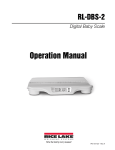
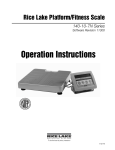
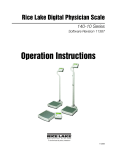
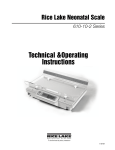

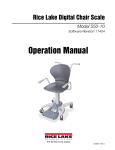


![Final Report - [Almost] Daily Photos](http://vs1.manualzilla.com/store/data/005658230_1-ad9be13b69bd4f2e15f58148160b0f22-150x150.png)



